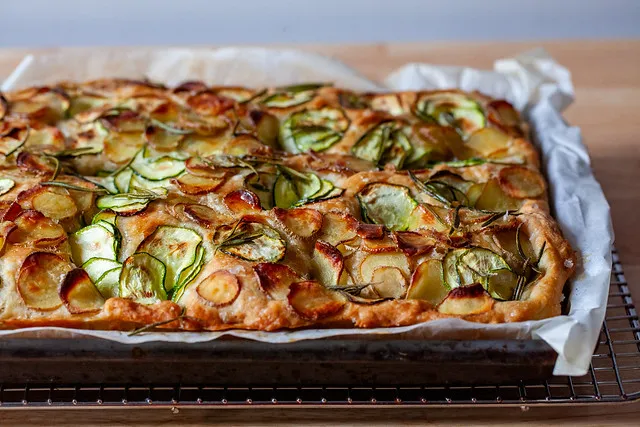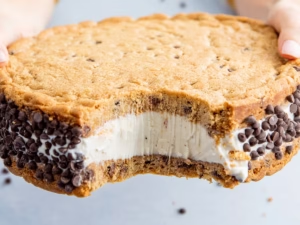Focaccia, with its golden crust and pillowy interior, is the kind of bread that feels like a warm hug from an Italian nonna. When topped with zucchini and potatoes, it transforms into a hearty, vegetable-packed masterpiece that’s as versatile as it is delicious. I first fell in love with this recipe during a summer trip to Liguria, Italy, where a local baker served me a slice of zucchini focaccia so good I begged for the recipe. In this 2,500-word guide, I’ll share how to make focaccia with zucchini and potatoes at home, complete with tips, tricks, and a touch of humor to make your baking adventure a breeze. Whether you’re a seasoned baker or a newbie, this recipe will have you serving up crispy, savory slices that’ll impress everyone at the table.
What Is Focaccia with Zucchini and Potatoes?
Focaccia is a traditional Italian flatbread known for its olive oil-rich dough, dimpled surface, and endless topping possibilities. Adding zucchini and potatoes creates a rustic, veggie-forward version that’s perfect as an appetizer, side dish, or even a light meal. The zucchini adds moisture and a subtle sweetness, while the potatoes bring a comforting, starchy texture.
A Taste of Italy
Picture this: a golden slab of focaccia, its edges crispy from olive oil, topped with thinly sliced zucchini and potatoes that are tender yet slightly caramelized. The scent of rosemary fills the air, and a sprinkle of flaky sea salt makes every bite pop. This is the kind of dish that transports you to a sun-drenched Italian piazza, even if you’re just in your kitchen.
Why Make This Focaccia?
This recipe isn’t just about bread—it’s about creating something that’s both nourishing and indulgent. It’s a crowd-pleaser for gatherings, a budget-friendly way to use summer veggies, and a forgiving recipe for beginner bakers.
My Italian Baking Adventure
During my trip to Liguria, I stumbled upon a tiny bakery where the owner, Maria, served zucchini focaccia fresh from the oven. I watched her knead the dough with practiced hands, and her secret? “Patience and good olive oil,” she said with a wink. That experience inspired me to recreate this dish at home, and after countless trials (and a few doughy disasters), I’ve perfected a recipe that’s easy yet authentic.
Ingredients for Zucchini and Potato Focaccia
The beauty of this focaccia lies in its simplicity. With just a handful of ingredients, you can create a bakery-worthy loaf. Here’s what you’ll need for the dough and toppings.
Dough Ingredients
- Flour: 3½ cups all-purpose flour (or bread flour for extra chew).
- Yeast: 2¼ tsp (1 packet) instant dry yeast.
- Water: 1½ cups lukewarm water (about 110°F).
- Olive Oil: 6 tbsp extra virgin olive oil, divided.
- Salt: 2 tsp kosher salt.
- Sugar: 1 tsp to activate the yeast.
Topping Ingredients
- Zucchini: 2 medium, thinly sliced or grated.
- Potatoes: 2 small, thinly sliced (Yukon Gold or red potatoes work best).
- Rosemary: 1 tbsp fresh, chopped (or 1 tsp dried).
- Sea Salt: Flaky, to taste.
- Olive Oil: 2 tbsp for drizzling.
- Optional: ½ cup shredded mozzarella or Parmesan for a cheesy twist.
Ingredient Notes
Use high-quality extra virgin olive oil for the best flavor—it’s the star of the show. Fresh zucchini and potatoes are ideal, especially in summer, but you can adapt with frozen or off-season veggies if needed.
Step-by-Step Recipe Instructions
Making focaccia is easier than you might think, especially with this no-fuss method. Follow these steps for a golden, veggie-topped loaf that’s crispy outside and soft inside.
Step 1: Prepare the Dough
In a large bowl, combine lukewarm water, yeast, and sugar. Let it sit for 5–10 minutes until frothy. Add flour, salt, and 1 tbsp olive oil, stirring until a sticky dough forms. Cover and let rise for 1–1½ hours until doubled.
Step 2: Shape the Dough
Line a 9×13-inch baking pan with parchment and drizzle with 3 tbsp olive oil. Scrape the risen dough into the pan, gently stretching it toward the edges without deflating it. Cover and let rise for another 45 minutes to 1 hour.
Step 3: Prep the Toppings
While the dough rises, slice zucchini and potatoes thinly (use a mandoline for uniformity). Toss with 1 tsp kosher salt each and let sit for 15 minutes to draw out moisture. Pat dry with paper towels to prevent a soggy focaccia.
Step 4: Assemble the Focaccia
Preheat oven to 450°F. Gently dimple the risen dough with your fingertips, creating about 20 impressions. Arrange zucchini and potato slices in a shingle pattern, sprinkle with rosemary, and drizzle with 2 tbsp olive oil. Finish with flaky sea salt.
Step 5: Bake and Serve
Bake for 30–35 minutes until golden brown and crispy at the edges. Let cool for 5 minutes, then slide onto a rack to prevent softening. Cut into squares and serve warm or at room temperature.
Tips for Perfect Focaccia
Getting that bakery-quality focaccia takes a few tricks, but don’t worry—I’ve got you covered with lessons learned from my own kitchen experiments.
Don’t Skimp on Olive Oil
Olive oil is the secret to focaccia’s signature crispy crust. Be generous when greasing the pan and drizzling the top. I once tried cutting back, and the result was a dry, lackluster loaf—never again!
Control Moisture in Veggies
Zucchini is watery, so salting and draining it is key to avoid a soggy bread. Potatoes need the same treatment to cook evenly. This step made a huge difference in my early batches.
Don’t Over-Dimple
Dimpling gives focaccia its classic look, but too much can flatten the dough, making it dense. Aim for gentle, spaced-out impressions to keep it airy.
Pros and Cons of This Recipe
| Aspect | Pros | Cons |
|---|---|---|
| Ease | Simple ingredients, no-knead option | Requires multiple rise times |
| Flavor | Rich, savory, veggie-packed | Can be soggy if veggies aren’t drained |
| Versatility | Great as appetizer, side, or main | Best eaten fresh; less crisp after a day |
Variations to Try
Focaccia is endlessly customizable, and this zucchini and potato version is just the start. Here are some ways to mix it up based on your tastes or pantry.
Cheesy Zucchini and Potato Focaccia
Add ½ cup shredded mozzarella or Parmesan before baking for a gooey, indulgent twist. I tried this for a potluck, and it disappeared in minutes
Herbed Focaccia with Extras
Swap rosemary for thyme, oregano, or sage, or add halved cherry tomatoes or olives for color and flavor. A friend in Italy swore by adding capers for a briny kick.
Vegan and Gluten-Free Options
Use gluten-free flour for a celiac-friendly version, and skip cheese for a vegan loaf. Spelt flour works well for a nuttier flavor, as I discovered during a gluten-free baking phase.
Comparison of Focaccia Styles
| Style | Toppings | Texture |
|---|---|---|
| Classic Focaccia | Olive oil, sea salt, rosemary | Crispy crust, airy middle |
| Zucchini & Potato | Zucchini, potatoes, optional cheese | Moist, hearty, slightly denser |
| Tomato & Zucchini | Cherry tomatoes, zucchini slices | Light, juicy, vibrant |
Tools You’ll Need
You don’t need fancy equipment, but a few tools make the process smoother. Here’s what I use in my kitchen.
Essential Baking Tools
- 9×13-inch Baking Pan: Ensures even baking and crispy edges. Shop on Amazon.
- Mandoline Slicer: For uniform zucchini and potato slices. Shop on Amazon.
- Mixing Bowl: A large one for dough prep.
- Parchment Paper: Prevents sticking and reduces oil use.
Where to Find Quality Ingredients
- Olive Oil: Look for extra virgin olive oil at local markets or online at Thrive Market.
- Flour and Yeast: Stock up at bulk stores like Costco or order from King Arthur Baking.
- Fresh Veggies: Farmers’ markets or grocery stores like Whole Foods for the freshest zucchini and potatoes.
Serving Suggestions
This focaccia shines as a versatile dish, perfect for any occasion. Here are my favorite ways to enjoy it, inspired by my Italian adventures.
As an Appetizer
Cut into small squares and serve with a dipping sauce like marinara or olive oil with balsamic. It’s a hit at parties—trust me, I’ve seen guests fight over the last piece!
As a Side Dish
Pair with a light salad or soup, like a cucumber-tomato salad or zucchini soup. In Liguria, I had it alongside a seafood stew, and it was divine.
As a Main Course
Top with extra cheese or serve with a protein like grilled chicken for a hearty meal. I’ve even used leftovers for sandwiches with pesto and mozzarella.
Storing and Reheating
Focaccia is best fresh, but with a few tricks, you can keep it tasty for days.
Storage Tips
Store at room temperature in an airtight container for up to 2 days. For longer storage, wrap tightly and refrigerate for 5 days or freeze for up to 3 months.
Reheating for Crispiness
Reheat in a 350°F oven for 5–10 minutes to restore the crispy top. Microwaving works in a pinch but can make it soggy, so avoid it if you can.
People Also Ask (PAA) Section
Here are answers to common Google questions about zucchini and potato focaccia.
How do you make focaccia with zucchini and potatoes?
Combine flour, yeast, water, olive oil, and salt to make a dough. Let it rise, then spread in a pan. Top with salted and drained zucchini and potato slices, rosemary, and olive oil. Bake at 450°F for 30–35 minutes until golden.
Can you add cheese to zucchini focaccia?
Yes, sprinkle shredded mozzarella or Parmesan before baking for a cheesy flavor. It adds richness but keeps the focaccia light if used sparingly.
What’s the best way to store focaccia?
Store at room temperature for 2 days in an airtight container. For longer, refrigerate for 5 days or freeze for 3 months. Reheat in a 350°F oven to restore crispiness.
Is zucchini focaccia vegan?
Yes, if you skip cheese, this recipe is naturally vegan. Use high-quality olive oil and fresh herbs to keep the flavor vibrant.
FAQ Section
How long does it take to make zucchini and potato focaccia?
Total time is about 3 hours, including 2 hours for dough rising, 15 minutes for prep, and 30–35 minutes for baking. It’s mostly hands-off, so you can multitask.
Can I use frozen zucchini or potatoes?
Yes, but thaw and pat dry thoroughly to avoid excess moisture. Fresh veggies give the best texture and flavor, though.
What’s the difference between focaccia and scarpaccia?
Focaccia is a yeasted bread with a thick, airy texture, while scarpaccia is a thinner, crispier Italian flatbread, often with a batter-like base.
How do I prevent soggy focaccia?
Salt and drain zucchini and potatoes before topping to remove excess water. Pat dry and don’t over-dimple the dough to maintain its structure.
Where can I find focaccia recipes?
Check Smitten Kitchen for a detailed recipe or The Plant Based School for a vegan version. YouTube channels like Ricette Fresche also have great tutorials.
Why This Recipe Works
This focaccia with zucchini and potatoes is a winner because it’s approachable, affordable, and bursting with flavor. The dough is forgiving, the toppings are customizable, and the result is a bread that’s as beautiful as it is tasty. My Liguria trip taught me that simple ingredients, when treated with care, can create something extraordinary. Whether you’re baking for a family dinner or a picnic, this focaccia will steal the show—just don’t be surprised if there are no leftovers!


